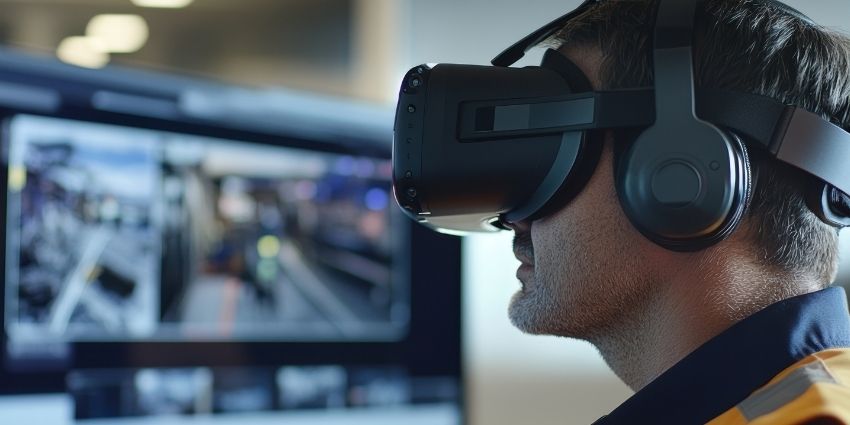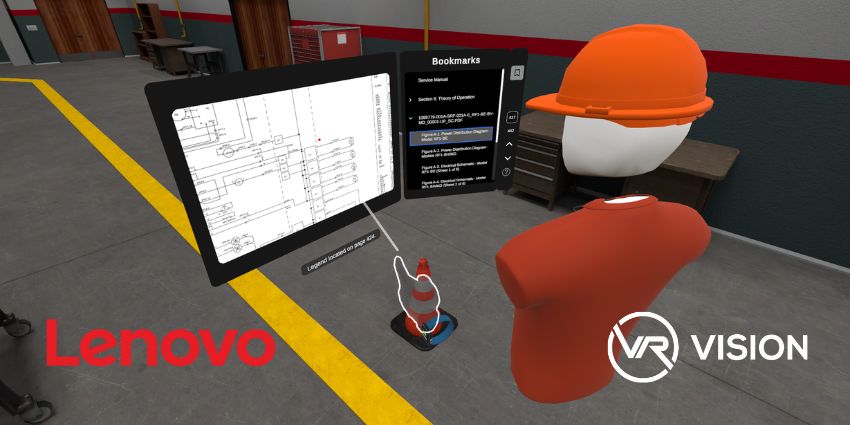The corporate training landscape is changing. Companies need a more intuitive, cost-effective, and scalable way to upskill and reskill teams, without traditional classroom settings. They’re discovering the immersive learning ROI (Return on Investment) is much higher than they thought.
After all, while investing in XR hardware and software can be expensive upfront, it often saves companies money in the long term. It reduces travel and material costs while improving retention rates and accelerating training times.
In fact, when companies scale their XR training initiatives to more than 3,000 employees, immersive learning becomes 52% less expensive than traditional classroom training, according to PWC.
- If you’re ready to elevate your training strategy, learn more about the world of immersive learning here, or discover the key benefits of immersive training in this guide.
So, what’s the true ROI of immersive education?
Immersive Learning ROI vs Traditional Training
Some companies, particularly smaller organizations, are often reluctant to invest in immersive learning due to the upfront costs. Investing in MR, AR, or VR headsets and cutting-edge software can be expensive. However, immersive learning is becoming more affordable, particularly now that we have headsets like the Meta Quest 3S to cut hardware costs.
Plus, the costs of traditional training are higher than companies realize. There are travel costs to consider for employees (particularly remote and hybrid teams). Then there are the productivity expenses created by employees spending hours in classrooms, rather than in the office.
On top of that, you’ll need account for facility costs (classrooms or conference spaces), instructor fees, material and resource costs, and more. Realistically, the immersive learning ROI is often higher than the return on investment from traditional training for numerous reasons.
Here’s a closer look at how immersive learning cuts costs.
Accelerating Training: Time Savings with Immersive Learning
According to PWC, immersive learning can reduce training time by around 75% – giving employees a quicker, more effective way to develop new skills.
Immersive learning eliminates travel time and long lectures, reduces the need for repetitive practice, and immerses employees deeper into training sessions. It allows users to interact with lifelike scenarios, developing muscle memory and experience rather than passively absorbing information.
According to XR leader, Immerse, the average company reports a 52% improvement in speed to competence, an $8.59 million increase in revenue by minimizing downtime, and a 50% reduction in total training time, accelerating returns to work.
As a real-world example, Provide Community saved their team 3,744 hours annually in training times, using RealWear AR headsets for on-the-job training and real-time mentoring. Immersive learning isn’t just faster – it’s smarter, more engaging, and more effective at getting employees up to speed with minimal downtime and maximum impact.
Immersive Learning ROI: Improved Productivity and Skill Retention
Lectures and e-learning modules often result in low retention rates, requiring costly refresher sessions and leading to on-the-job mistakes. Some studies suggest people forget around 70% of what they learn in a traditional training session in 24 hours and 90% within a week.
Alternatively, PWC, examining immersive learning ROI, found that XR training improved learning retention by 75%. Employees in XR simulations actively participate in real-world scenarios, reinforcing skills through practice. For example, Credit Agricole used immersive training to support their finance teams, and found the majority of staff were immediately more confident in applying their skills to their roles, and made fewer mistakes.
VR training lets employees practice in risk-free environments, reducing on-the-job errors, and reducing the need for retraining or additional development. Immersive learning not only speeds up time to competency, but it also helps teams hold onto skills for longer, making them more productive, efficient, and cost-effective.
Immersive Learning ROI: Reduced Risk = Fewer Costs
In high-risk industries, training isn’t just about learning – it’s about staying safe. Mistakes in fields like aviation, healthcare, and manufacturing can have catastrophic consequences, making hands-on experience essential.
XR solutions allow companies to provide employees with a safe, controlled environment where they can practice complex, high-stakes tasks without danger. This reduces the costs of building simulated training environments or paying for the repercussions of serious mistakes.
For instance, Boeing uses VR to train astronauts, allowing them to experiment with emergency procedures and rehearse space missions, all without the need to physically build training environments with cutting-edge technology.
By reducing workplace accidents, cutting down liability costs, and ensuring that employees are truly prepared, VR training doesn’t just protect workers—it protects businesses from financial and reputational damage.
Simple Scalability: Immersive Learning at Large
Consider how much it actually costs to scale a traditional training initiative across departments. There are extra fees for resources and materials, expert instructors, and additional downtime has an impact on a company’s revenue. One of the reasons immersive learning ROI can be so huge, is that extended reality solutions are easier (and cheaper) to scale.
Companies only need to invest in one set of headsets that can be shared among teams, and once they’ve paid for a training module, it can be used infinitely without extra expenses. No need to schedule sessions or pay instructors. Teams can complete training tasks in their free time, without having to switch off crucial machinery, or take up a lot of space in a training room.
For instance, Volkswagen uses extended reality across ten global sites to train employees in vehicle assembly, design, and safety protocols. Instead of flying trainers to multiple locations or disrupting production lines for hands-on training, Volkswagen employees can access the same VR modules remotely, ensuring standardized, high-quality training across all sites.
The Immersive ROI Feedback Loop: Improving Over Time
While employees taking traditional training sessions can provide feedback, and educators can score performance, the insights into what’s really working for teams are limited. Immersive learning solutions gather in-depth data from every session.
XR training generates real-time data on how employees interact with simulations, make decisions, and apply skills. This creates an immersive learning ROI feedback loop, allowing organizations to refine training programs, close skill gaps, and continuously improve performance.
Decision-making patterns, reaction times, and error rates provide rich analytics that reveal where employees struggle – and where they excel. These insights help fine-tune training modules, ensuring they focus on the skills employees actually need rather than just what organizations assume they need. This way, companies can improve ROI over time.
For instance, Deutsche Telekom used VR training to enhance employee communication skills. By analyzing data from XR sessions, the company identified specific soft skill gaps, allowing them to tailor their programs for better engagement and real-world effectiveness.
Immersive Learning ROI: Real World Insights
Countless organizations across industries have already achieved an incredible immersive learning ROI. They’re accelerating training times, reducing material costs and risks, and improving the scalability of their development programs. Just a few examples include:
- Walmart: Walmart integrated VR training across 4,700 stores, using Strivr’s immersive learning platform to prepare employees for high-pressure scenarios – like Black Friday crowds. By simulating real-world challenges, Walmart employees learned 10-15% faster and retained information significantly better than through traditional training.
- Intel: Intel used VIVE VR to train employees on complex manufacturing processes. Traditionally, this training required weeks of in-person instruction, but with VR, training time was slashed by 94% – from weeks to just four hours. Not only did Intel cut costs on travel and instructor fees, but employees also mastered skills faster and with higher accuracy, reducing production errors.
- TRU Simulation: Flight training is expensive and high-risk, but TRU Simulation leveraged Varjo’s ultra-realistic VR technology to create advanced pilot training simulations. Pilots could practice emergency procedures without the cost of using real aircraft. The result? A safer, more cost-effective training program that scaled quickly.
Maximizing Immersive Learning ROI: Quick Tips
Investing in immersive learning is a smart move for any company looking to increase the ROI of its training initiatives. However, you still need to get the implementation process right. To truly optimize immersive learning ROI, you need to go beyond buying headsets and software.
Here are some top tips for success:
- Start Small, Scale Smart: Jumping into immersive learning doesn’t mean overhauling your entire training program overnight. Begin with one high-impact use case – like onboarding, safety training, or soft skills development. Once you see measurable success, scale gradually to maximize value without unnecessary upfront costs.
- Use Real-World Data: One of immersive learning’s biggest advantages is its ability to generate real-time performance data. Use analytics to track decision-making trends, response times, and knowledge retention. These insights help fine-tune training modules.
- Create Scalable Content: Develop VR and AR training modules that can be repurposed across different roles and departments. Instead of building one-off simulations, invest in a modular design that allows for easy updates and expansions. This reduces content creation costs over time while keeping training fresh and relevant.
- Use the Cloud: VR headsets are becoming cheaper and more accessible, but companies can further cut costs by using cloud-based XR platforms. These allow employees to train on multiple devices, reducing the need for expensive hardware purchases.
Immersive Learning ROI: A Smart Investment
Immersive learning is an incredible resource for modern companies, making it easier for businesses to deliver and scale engaging training experiences across departments. The right strategy can help you cut costs on materials and resources, while also accelerating the path to competency, improving employee engagement, and boosting knowledge retention.







